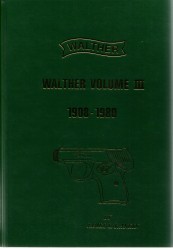CRUFFLER.COM
presents
HISTORIC
FIREARM OF THE MONTH,
March
2000:
 |
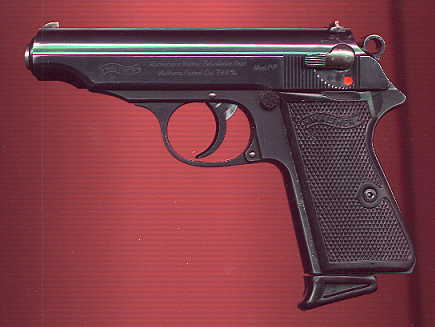
Image credit: The Unofficial Walther Homepage http://www.geocities.com/Pentagon/Quarters/2188/pp.jpg |
Type:
Double Action Self Loading Pistol
System of Operation: Blowback Caliber: 5.25mm (.22 LR), 6.35mm Browning (.25 ACP) 7.65mm Browning (.32 ACP), 9mm Browning Short (.380 ACP) Capacity: Detachable box magazine, 8 rounds in 7.65mm Sights: U-notch rear, Blade front Length: 6.81" Weight (unloaded): 24 ounces Barrel: 3.87" |
The Walther PP pistol has a long and distinguished history that can be traced back to the earliest days of gunsmithing. In this article we will trace the history of the PP, and, by association that of Waffenfabrik Walther, from its earliest beginnings to the latter part of the twentieth century.
The state of Thuringen, in the eastern portion of Germany has long been home to one of the great gunmaking centers of the world. In 1592 the gunsmiths of the area around Thuringa forest formed a gunsmith's guild. The guild was incorporated in the town of Zella St. Blasii. 294 years later, in 1886, a twenty-six year old engineer named Carl Walther began operating a small gun shop, Waffenfabrik Walther, in Zella St. Blasii. Walther's first products were shotguns, hunting rifles, and small pocket pistols. As Waffenfabrik Walther became more successful, it expanded both in size and in scope, producing such diverse items as office machinery in addition to firearms. However, it was not until 1908 that Walther marketed his first successful self loading pistol.
EARLY
PISTOL PATTERNS
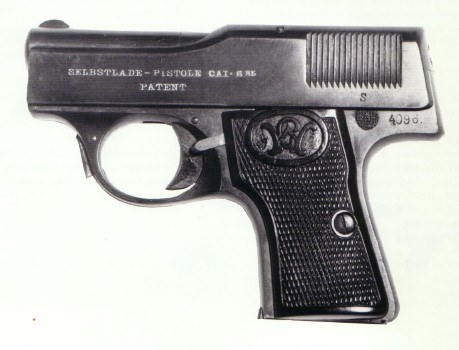
Walther Model 1 Image Credit: Rankin, James L., Walther Volume III, 1908-1980, (Coral Gables, Florida, 1981) Page 20 |
This first pistol was called the Model 1 (or alternatively the Model 1908), and was a small, blowback operated, pocket pistol chambered for 6.35mm Browning. The top part of the slide is cut away so as to expose the barrel from the muzzle to the breech, and an internal hammer and recoil spring are located below the barrel. The Model 1's safety was of the cross bolt push type located on the rear frame. The Model 1 was approximately 4.375" long and weighs 12.8 ounces. Magazine capacity was six rounds. |
The Model 1 was followed in 1909 by the Model 2. The Model 2 was an improved Model 1, also chambered for the 6.35mm Browning. On the Model 2 the slide fully encloses
| the barrel, and ends in a knurled barrel bushing. The knurled bushing serves as both a take down latch and the mechanism by which the recoil spring is retained in the slide. This model dispensed with the earlier crossbolt safety in favor of a lever located on the left side of the frame. One of the more interesting features of the Model 2 was the cocking indicator; unless there is a cartridge in the pistol's chamber, the rear sight is retracted into the slide. The Model 2 was 4.25" long and weighed 9.75 ounces. |
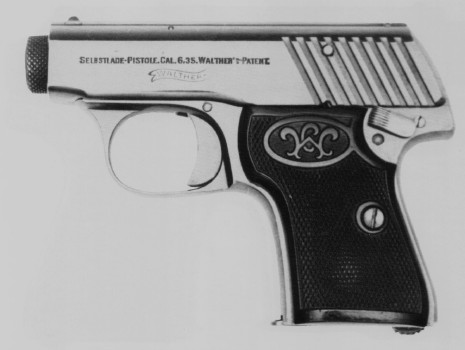
Walther Model 2 Image Credit: Rankin, James L., Walther Volume III, 1908-1980, (Coral Gables, Florida, 1981) Page 27 |
In 1910, Walther introduced the Model 3. The Model 3 was a blowback operated pocket pistol chambered for the 7.65mm Browning. It was larger and heavier, and
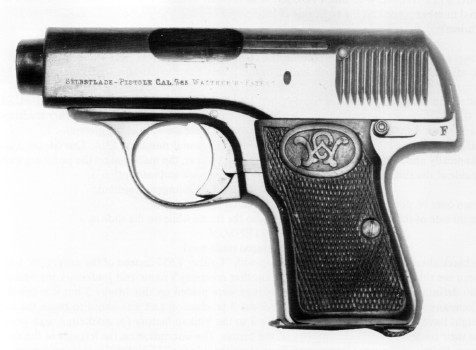
Walther Model 3 Image Credit: Rankin, James L., Walther Volume III, 1908-1980, (Coral Gables, Florida, 1981) Page 29 |
demonstrated a significant improvement in workmanship over the earlier guns. As on the Model 2 the slide encloses the barrel and ends in a dual purpose barrel bushing. The safety lever is located on the left rear of the frame. The Model 3 had no sights, but did have a sighting groove milled into the top of the slide. Rare among Walther pistols, the ejection port on the Model 3 is located on the left side of the slide. Length was about 5", and weight was 16.5 ounces. Magazine capacity was six rounds. |
The next Walther pistol, the Model 4, was introduced concurrently with the Model 3, in 1910. It too was a blowback operated pistol chambered for the 7.65mm Browning. It was larger than the earlier models, being of the size for which a holster might be deemed necessary, but the longer grips and barrel improved the pistol's handling and pointing characteristics. The Model 4 was the first Walther pistol to achieve notable
| commercial success, and many were used by police agencies as well as the German military during World War One. The pistol has an elongated barrel bushing which serves the same purpose as that on the earlier pistols, but in addition, also carries the front sight. Model 4's were manufactured between 1910 and 1918. The Model 4 was 6" long and weighed about 18.5 ounces. Magazine capacity was eight rounds. |
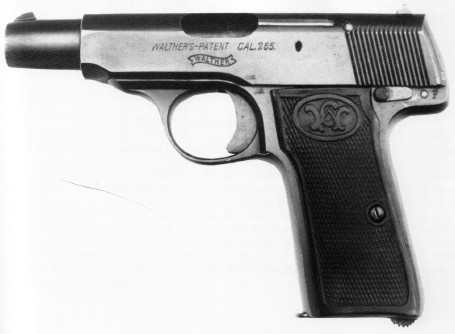
Walther Model 4 Image Credit: Rankin, James L., Walther Volume III, 1908-1980, (Coral Gables, Florida, 1981) Page 35 |
In 1913, Walther brought out the Model 5. The Model 5 was little more than an updated and revised Model 2, and was also chambered for the 6.35mm Browning. The Model 5 demonstrated higher standards of manufacture and finish than the Model 2, and indeed was the first small Walther pistol to garner international attention and acclaim. As with
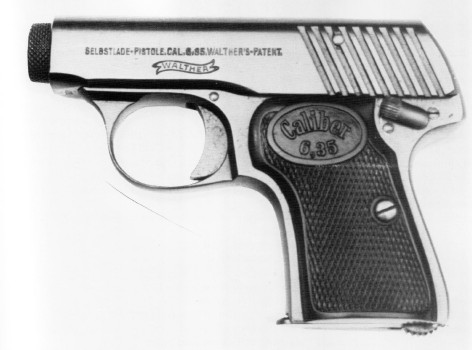
Walther Model 5 Image Credit: Rankin, James L., Walther Volume III, 1908-1980, (Coral Gables, Florida, 1981) Page 41 |
the earlier guns, the Model 5 was blowback operated, with an enclosed slide and a knurled barrel bushing that served as both takedown latch and recoil spring retaining nut. Earlier versions of the Model 5 had no sights, just a sight groove milled into the top of the slide, while later versions had fixed front and rear sights. The Model 5 was approximately 4.25" long and weighed 9.5 ounces. Magazine capacity was eight rounds. |
The Walther Model 6 was introduced in 1915. The Model 6 was, in reality very little more than an enlarged Model 4 with some minor modifications. It was produced in an effort to profit from the Imperial German Army's desperate need for pistols during the First World War. As such, it was chambered for the German service cartridge, the 9mm
| Parabellum, and was the first Walther pistol in this chambering. Mechanically, the Model 6 was no different than the Model 4, being a straight blowback pistol with a concealed hammer. As on the Model 4, the dual purpose barrel bushing also provided a base for the front sight. The Model 6 is comparatively rare, having been manufactured for only two years. The Model 6 was approximately 8.25" long, and weighed 34 ounces. Magazine capacity was eight rounds. |
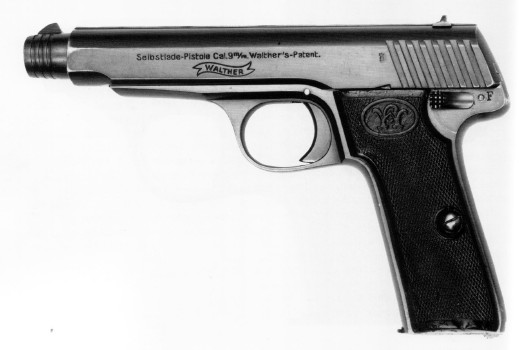
Walther Model 6 Image Credit: Rankin, James L., Walther Volume III, 1908-1980, (Coral Gables, Florida, 1981) Page 44 |
The Model 7 was introduced in 1917, and produced for less than twelve months. It
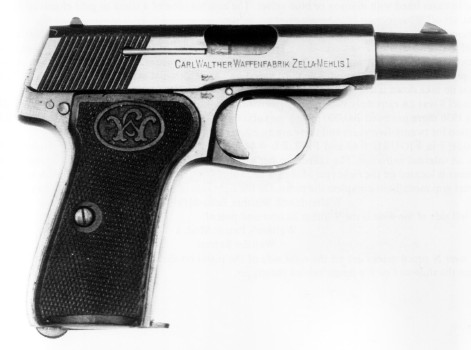
Walther Model 7 Image Credit: Rankin, James L., Walther Volume III, 1908-1980, (Coral Gables, Florida, 1981) Page 47 |
was chambered for the 6.35mm Browning. The Model 7 was essentially a smaller version of the Model 6. Despite being scaled down, this was still the largest 6.35mm Walther pistol to date. One of the Model 7's primary users was the German military, with many officers carrying it as a substitute standard sidearm during the First World War. The Model 7 was approximately 5.67" long and weighed 12 ounces. Magazine capacity was eight rounds. |
In 1920, Walther brought out its first post-war pistol, the Model 8. This was a small 6.35mm Browning pocket pistol that should be considered the first of the modern Walthers. It has many of the features that were later found on the PP, and may be considered the direct ancestor of the modern Walthers. While the Model 8 was a blowback pistol with a concealed hammer, it had several design features that were revolutionary for Walther. The slide enclosed the entire barrel, and retained the
| recoil spring as well, dispensing with the barrel bushing. Disassembly was accomplished via the now familiar method of pulling the hinged trigger guard down while pulling the slide to the rear and up. There was even a variant was offered with an aluminum alloy frame. The Model 8 was a great commercial success, with some 500,000 being produced by the end of the Second World War. The Model 8 was approximately 5" in length, and weighed 12.5 ounces. Magazine capacity was eight rounds. |
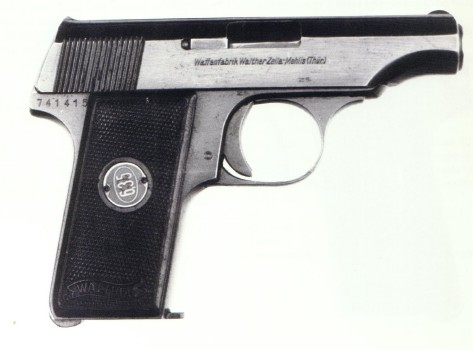
Walther Model 8 Image Credit: Rankin, James L., Walther Volume III, 1908-1980, (Coral Gables, Florida, 1981) Page 49 |
In 1921, one year after the Model 8 was introduced, Walther brought out the Model 9.
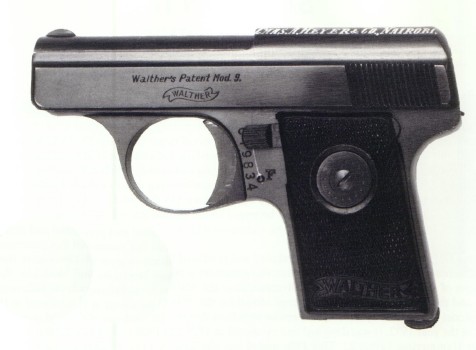
Walther Model 9 Image Credit: Rankin, James L., Walther Volume III, 1908-1980, (Coral Gables, Florida, 1981) Page 55 |
The Model 9, a small blowback pocket pistol chambered for the 6.35mm Browning, was essentially an updated version of the Walther Model 1. As in the Model 1, the top of the slide is cut away to expose the full length of the barrel. The Model 9 had an cocking indicator pin that protrudes from the rear of the slide when the gun is cocked. The Model 9 was approximately 4" long and weighed 9 ounces. Magazine capacity was 6 rounds. |
POLIZEI
PISTOLE - THE WALTHER PP
The
years between the introduction of the Walther Model 9, in 1921, and 1929
were a period of relative calm in the handgun industry. Older models
were refined, and true innovation was limited. There were few new
models introduced, and those that were generally followed established norms.
In 1929, Walther introduced a new pistol which would take the world by
storm, and which, to this day, influences pistol design. The
new pistol was called the "Polizei Pistole," or "Police Pistol," commonly
referred to as the "PP." (The PP's law enforcement designation was
a comment on the safety with which it could be carried with a round in
the chamber - the idea being that police officers were the group most likely
to need the rapid first shot.)
WALTHER
PP FUNCTIONAL CHARACTERISTICS
The
PP was the first successful double action self loading pistol. The
double action mechanism meant that the pistol could be safely carried with
a round in the chamber, ready to fire. The trigger pull on the first shot
would be a longer heavier pull (not unlike that of a double action revolver)
than subsequent shots. After the first shot, the reciprocation of the slide
would cock the hammer for follow up shots if necessary. Overnight,
the PP made all other concealable pistols virtually obsolete. Like
the other Walther pistols, the PP was blowback operated, and a magazine
actuated slide stop caused the slide to remain to the rear after the last
shot had been fired. The pistol's mechanism includes a disconnector
which prevents more than one shot from being fired with each pull of the
trigger (although there were experimental models that had selector switches
to enable fully automatic fire.
A cartridge indicator pin is found on most PP's, with the exception of those models chambered for the 5.25mm (.22 LR) cartridge. The indicator lies in a tunnel bored in the slide above and parallel to that for the firing pin. When there is a cartridge in the chamber, the rear of the case impinges on the pin and forces it to the rear, where it protrudes from the back of the slide, indicating to the shooter that there is indeed a round in the chamber. The cartridge indicator was a factory option, thus explaining early PP's found without it. By the end of the Second World War, and in the interests of production rapidity, the cartridge indicator was generally omitted.
Almost all PP's have fixed sights, a blade front and a u-notch rear. The rear sight is drift adjustable for windage. Most PP's have a push button magazine release catch located on the left side of the frame behind the trigger. However, there are some in 7.65mm and 9mm Browning Short that have a heel-clip magazine release located at the base of the frame at the rear of the magazine well.
The safety lever is located on the left side of the slide in that portion of the slide milled with cocking serrations. When the safety lever is pointing forward, the pistol is ready to fire. When it is pointed downwards, the pistol is on safe. Some models of the PP (notably those made early in the production run) have a lever that rotates through ninety degrees to the safe position, but most safety levers rotate through sixty degrees. When the safety is applied, the sear is locked, the trigger and hammer cannot be moved through much, if any, of their range of motion, and the safety's spindle rotates such that it blocks the hammer from striking the firing pin.
| If
the hammer is in the cocked position and the safety is applied, the hammer
is automatically dropped onto the safety spindle, which prevents firing.
The trigger is not returned to the forward position until the safety is
placed in the fire position.
FINISHES
|
Many refer to the safety on the Walther PP as a "hammer drop," and are content to simply thumb the safety and let the hammer fall. The overwhelming majority of the time, this leads to no perceivable ill result. That is to say, the pistol doesn't inadvertently fire. The problem to this approach is that every time the hammer falls, it falls on a rigidly held piece of metal. Eventually, the rigidly held piece of metal, the safety spindle in this case, will succumb to the battering, and crack and break. There is no way to observe this from the outside. This can lead to accidental discharge, injury or death. SO. . . . when you use the safety to lower the hammer on a PP or a PP clone, your best bet is to ease the hammer down. |
MARKINGS
The
serial number was generally located on the right side of the frame behind
the trigger, parallel with the angle of the grip. Some PP's have
a second serial number on the right side of the slide, forward of the ejection
port. Additionally some pistols were shipped with two magazines serial
numbered to the gun.
Walther factory markings were generally found on the left side of the slide. They consisted of:
|
Walther's Patent Cal 7,65m/m Mod PP |
Pre-1945 PP's bore one of two sets of proof marks. The first were the proof marks in use in Germany between April, 1893 and April, 1940. These consisted of a crown over the letter N (for Nitro or smokeless powder). These markings can be found on the right side of the slide below the ejection port, the right side of the frame above the trigger, on the chamber face, and on the right side of the barrel near the muzzle. The other proof marks were the Nazi commercial proofs, put into effect in April, 1940 until the end of the war. These consisted of a Nazi Eagle over an N, and will be found in the same locations as the earlier proof marks.
For those guns seeing Nazi military service, acceptance stamps ("Waffenamt Stempeln") are found on the left side of the frame to the rear of the trigger and on the left side of the slide to the front of the cocking serrations. For those guns seeing police service, the police acceptance marking is found either on the left side of the frame to the rear of the trigger or on the right front trigger guard webbing.
POST-WAR
PP'S
After
the war, the Walther factory in Zella-Mehlis was in the newly formed East
Germany, and most of the machinery was taken away to the east by the occupying
Soviet forces. Carl Walther's heir, Fritz was lucky to escape to
the west. Through shrewd legal maneuvering, Fritz Walther was able
to maintain the pre-war patents to the PP, and its smaller brother the
PPK. Anxious to build up the necessary capital to open a new Walther
plant, Fritz Walther entered into contracts with various firms outside
of Germany to produce the Walther pistols. One of the most successful
of these commercial collaborations was with Manufacture de Machines du
Haut-Rhin, located at Mulhouse, France, which went by the trade name Manurhin.
In the early 1950's, the Manurhin factory began to manufacture Walther
PP's and PPK's. These pistols were identical in every way, to include
the high standard of finish, to the pre-war Walthers. The only exceptions
were the markings on the grips and the slide. Slide markings on Manurhin
Walthers are as follows:
|
DU HAUT-RHIN MOD.PP Cal 7,65mm Made in France |
Production of the Walther PP continues to this day.
BIBLIOGRAPHY
Rankin, James L., Walther Models PP and PPK, 1929 - 1945, (Coral Gables, Florida: 1994)
Rankin, James L., Walther Volume III, (Coral Gables, Florida: 1981)
Walther
Models PP and PPK is available from IDSA Books. Click on the
image to order:
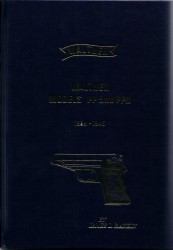
Walther
Volume III is available from IDSA Books. Click on the image to
order:
